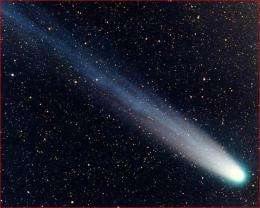November 12, 2010 report
'Necropanspermia' suggested as a way of seeding life on Earth

(PhysOrg.com) -- Panspermia is a mechanism for spreading organic material throughout the galaxy, but the destructive effects of cosmic rays and ultraviolet light tend to mean most organisms would be destroyed or arrive on a new world broken and dead. Now Paul S. Wesson, a visiting researcher at the Herzberg Institute of Astrophysics in Canada, suggests the information contained within damaged organic material could seed new life. He terms this process necropanspermia.
Many possible forms of panspermia have been proposed in the past, beginning in 1871 when Lord Kelvin suggested life could be transported within comets or meteors. With all of the proposals a major problem is that electromagnetic radiation and cosmic rays kill or inactivate microorganisms and break the chemical bonds binding molecules such as DNA and RNA together. Microorganisms eventually become inactivated or killed even if shielded within rock such as a comet, meteor or grains of space dust, and while they may possibly survive a journey within the solar system, they would be extremely unlikely to survive a lengthy trip from outside the solar system.
Calculations by other researchers have suggested it is not possible for random chemical interactions to produce the genetic information found on Earth, since over a period of 500 million years the random chemical reactions in a primordial "soup" of amino acids would only produce 194 "bits" of information, which is far short of the estimated 120,000 bits in a typical virus.
Wesson speculates there are two ways to explain life originating on Earth. One is that the chemical interactions were not random but governed by "some directed molecular process," and the other is that life on Earth was seeded by organic material that had already developed genetic content elsewhere. Since the processes of panspermia are so destructive, Wesson says the most likely form the organic material would take is dead or inactivated virus-like material carried in grains of space dust.
Wesson says the dead material could be resurrected if the environment of the new world is hospitable, and he points out that some micro-organisms "possess remarkably effective enzyme systems that can repair a multitude of strand breaks." His paper is unclear, however, on the mechanism by which dead bits of genetic material could be resurrected.
According to Wesson the necropanspermia theory could be tested by means such as searching for organic material in the outer solar system, and by laboratory experiments to determine "if genetic 'rubble' can reconstitute itself to form viable replicating molecules."
More information: Panspermia, Past and Present: Astrophysical and Biophysical Conditions for the Dissemination of Life in Space, by Paul S. Wesson, Space Science Reviews, DOI:10.1007/s11214-010-9671-x
© 2010 PhysOrg.com


















